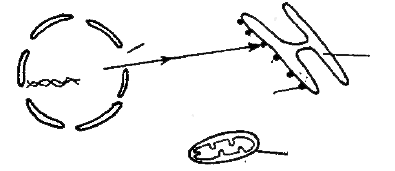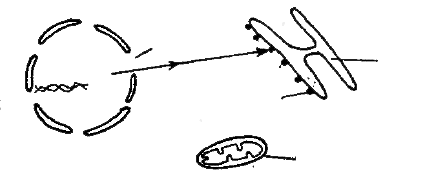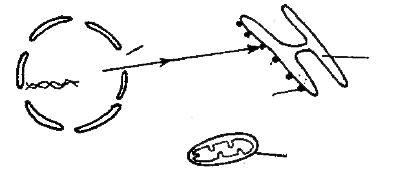Illustrate only a plant cell as seen under electron microscope. How its different from animal cell?
Step-by-Step Text Solution
Step 1: Illustration of a Plant Cell
To illustrate a plant cell as seen under an electron microscope, draw the following components:
1. Cell Wall: A rigid outer layer that provides structure and protection.
2. Cell Membrane: Inner to the cell wall, it regulates what enters and exits the cell.
3. Cytoplasm: The jelly-like substance where organelles are suspended.
4. Chloroplasts: Green organelles that contain chlorophyll for photosynthesis.
5. Large Central Vacuole: A prominent organelle that stores nutrients and waste products, and helps maintain turgor pressure.
6. Nucleus: The control center of the cell containing genetic material.
7. Endoplasmic Reticulum (ER): A network of membranes involved in protein and lipid synthesis.
8. Golgi Apparatus: The organelle responsible for modifying, sorting, and packaging proteins.
9. Mitochondria: The powerhouse of the cell, generating energy.
Step 2: Differences Between Plant and Animal Cells
Now, let's outline the key differences between plant cells and animal cells:
1. Cell Wall:
- Plant Cell: Has a rigid cell wall made of cellulose.
- Animal Cell: Lacks a cell wall; only has a flexible cell membrane.
2. Plastids:
- Plant Cell: Contains plastids (like chloroplasts) for photosynthesis.
- Animal Cell: Does not have plastids.
3. Vacuoles:
- Plant Cell: Contains one large central vacuole that occupies most of the cell volume.
- Animal Cell: Contains several small vacuoles.
4. Centrioles:
- Plant Cell: Centrioles are absent.
- Animal Cell: Centrioles are present and play a role in cell division.
5. Shape:
- Plant Cell: Generally has a fixed, rectangular shape due to the cell wall.
- Animal Cell: Typically has a more irregular shape.
Summary
In summary, a plant cell under an electron microscope exhibits distinct features such as a cell wall, chloroplasts, a large central vacuole, and the absence of centrioles, which differentiate it from an animal cell.
To illustrate a plant cell as seen under an electron microscope, draw the following components:
2. Cell Membrane: Inner to the cell wall, it regulates what enters and exits the cell.
3. Cytoplasm: The jelly-like substance where organelles are suspended.
4. Chloroplasts: Green organelles that contain chlorophyll for photosynthesis.
5. Large Central Vacuole: A prominent organelle that stores nutrients and waste products, and helps maintain turgor pressure.
6. Nucleus: The control center of the cell containing genetic material.
7. Endoplasmic Reticulum (ER): A network of membranes involved in protein and lipid synthesis.
8. Golgi Apparatus: The organelle responsible for modifying, sorting, and packaging proteins.
9. Mitochondria: The powerhouse of the cell, generating energy.
Now, let's outline the key differences between plant cells and animal cells:
- Plant Cell: Has a rigid cell wall made of cellulose.
- Animal Cell: Lacks a cell wall; only has a flexible cell membrane.
- Plant Cell: Contains plastids (like chloroplasts) for photosynthesis.
- Animal Cell: Does not have plastids.
- Plant Cell: Contains one large central vacuole that occupies most of the cell volume.
- Animal Cell: Contains several small vacuoles.
- Plant Cell: Centrioles are absent.
- Animal Cell: Centrioles are present and play a role in cell division.
- Plant Cell: Generally has a fixed, rectangular shape due to the cell wall.
- Animal Cell: Typically has a more irregular shape.
In summary, a plant cell under an electron microscope exhibits distinct features such as a cell wall, chloroplasts, a large central vacuole, and the absence of centrioles, which differentiate it from an animal cell.
Topper's Solved these Questions
- BOOK - NCERT EXEMPLAR ENGLISHCHAPTER - THE FUNDAMENTAL UNIT OF LIFE EXERCISE - Short Anwer Type Questions23videos
THE FUNDAMENTAL UNIT OF LIFE
- BOOK - NCERT EXEMPLAR ENGLISHCHAPTER - NATURAL RESOURCES EXERCISE - Long Answer Type Questions7videos
NATURAL RESOURCES
- BOOK - NCERT EXEMPLAR ENGLISHCHAPTER - TISSUESEXERCISE - Long answer9videos
TISSUES
Similar Questions
Minimum cell size seen under light microscope is
View SolutionWhat is cancer ? How it is different from a normal cell ?
View SolutionWhat is cancer ? How it is different from a normal cell ?
View SolutionGolgi apparatus was first seen under electron microscope by
View SolutionHow is cancerous cell different from a normal cell?
View SolutionPlant cell differs from animals cell by
View SolutionPlants differ from animals in having
View SolutionThe diagram below-shows features of an animal cell as seen under electron microscope :

What is the relationship of E and C?View SolutionThe diagram below-shows features of an animal cell as seen under electron microscope :

Name the structure B.View SolutionThe diagram below-shows features of an animal cell as seen under electron microscope :

Name the structure D.View Solution

